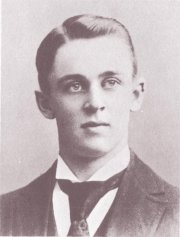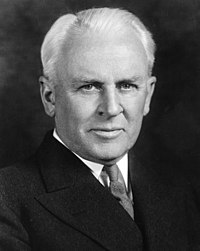Robert Andrews Millikan
Robert Andrews Millikan
Nascimento
22 de março de 1868 Morrison
Morte
19 de dezembro de 1953 (85 anos)San Marino
Sepultamento
Forest Lawn Memorial Park (Glendale)
Nacionalidade
estadunidense
Cidadania
Estados Unidos
Cônjuge
Greta Millikan
Filho(a)(s)
Clark Blanchard Millikan , Glenn Allan Millikan, Max Millikan
Alma mater Oberlin College Universidade Columbia
Ocupação
físico , professor universitário
Distinções
Prêmio Comstock de Física (1913)Medalha Edison IEEE (1922)Nobel de Física (1923)Medalha Hughes (1923)Medalha Matteucci (1925)Medalha ASME (1926)Medalha Franklin (1937)Medalha Oersted (1940)
Empregador(a)
Universidade de Chicago , Instituto de Tecnologia da Califórnia
Orientador(a)(es/s)
Michael Pupin Albert Abraham Michelson
Orientado(a)(s)
Chung-Yao Chao Robley Evans Harvey Fletcher Charles Christian Lauritsen William Hayward Pickering Ralph Alanson Sawyer
Instituições
Universidade de Chicago Instituto de Tecnologia da Califórnia
Campo(s)
física
Religião
congregacionalismo
Causa da morte
enfarte agudo do miocárdio
Robert Andrews Millikan (Morrison , 22 de março de 1868 — San Marino , 19 de dezembro de 1953 ) foi um físico experimental estadunidense .
Carreira
Milikan foi o primeiro cientista a determinar o valor da carga do elétron através da experiência da gota de óleo , que por meio de gotículas de óleo o possibilitou chegar a este valor até hoje adotado.[ 1] Nobel de Física de 1923, por trabalhos sobre cargas elétricas elementares e o efeito fotoeléctrico .[ 2] Instituto de Tecnologia da Califórnia (o órgão dirigente da escola na época) de 1921 até sua aposentadoria em 1945, Millikan ajudou a transformar a escola em uma das principais instituições de pesquisa nos Estados Unidos.[ 3] [ 4] Science Service , atualmente conhecido como Society for Science & the Public , de 1921 a 1953.
Laboratory course in physics for secondary schools , 1906Millikan, Robert Andrews (1906). Laboratory course in physics for secondary schools Millikan, Robert Andrews (1922). Practical physics Goodstein, D., "In defense of Robert Andrews Millikan Engineering and Science , 2000. No 4, pp30–38 (pdf).
Millikan, R A (1950). The Autobiography of Robert Millikan
Millikan, Robert Andrews (1917). The Electron: Its Isolation and Measurements and the Determination of Some of its Properties . The University of Chicago Press.
Nobel Lectures, "Robert A. Millikan – Nobel Biography
Segerstråle, U (1995) Good to the last drop? Millikan stories as "canned" pedagogy, Science and Engineering Ethics vol 1, pp197–214
Robert Andrews Millikan "Robert A. Millikan – Nobel Biography
The NIST Reference on Constants, Units, and Uncertainty Kevles, Daniel A (1979). «Robert A. Millikan». Scientific American . 240 (1): 142–151. Bibcode :1979SciAm.240a.142K . doi :10.1038/scientificamerican0179-142 Kargon, Robert H (1977). «The Conservative Mode: Robert A. Millikan and the Twentieth-Century Revolution in Physics». Isis . 68 (4): 509–526. JSTOR 230006 . doi :10.1086/351871 Kargon, Robert H (1982). The rise of Robert Millikan: portrait of a life in American science . Ithaca: Cornell University Press. Robert Andrews Millikan em 1891
1899–1925 1926–1950 1951–1975 1976–2000 2001–Presente
1909–1925 1926–1950 1951–1975 1976–2000 2001–atualidade
1901–1925 1926–1950 1951–1975 1976–2000
1976: Richter e Ting 1977: P. W. Anderson , Mott e Van Vleck 1978: Kapitsa , Penzias e Wilson 1979: Glashow , Salam e Weinberg 1980: Cronin e Fitch 1981: Bloembergen , Schawlow e Siegbahn 1982: Wilson 1983: Chandrasekhar e Fowler 1984: Rubbia e Van der Meer 1985: Klitzing 1986: Ruska , Binnig e Rohrer 1987: Bednorz e Müller 1988: Lederman , Schwartz e Steinberger 1989: Ramsey , Dehmelt e Paul 1990: Friedman , Kendall e R. E. Taylor 1991: de Gennes 1992: Charpak , Hulse e J. H. Taylor 1993: Brockhouse e Shull 1994: Perl e Reines 1995: D. Lee , Osheroff e R. Richardson 1996: Chu , Cohen-Tannoudji e Phillips 1997: Laughlin , Störmer e Tsui 1998: Hooft e Veltman 1999: Alferov , Kroemer e Kilby 2001–2024
2001: Cornell , Wieman e Ketterle 2002: Davis , Koshiba e Giacconi 2003: Abrikosov , Ginzburg e Leggett 2004: Gross , Politzer e Wilczek 2005: Glauber| , Hall e Hänsch 2006: Mather e Smoot 2007: Fert e Grünberg 2008: Nambu , Kobayashi e Masukawa 2009: Kao , Boyle e G. Smith 2010: Geim e Novoselov 2011: Perlmutter , Riess e Schmidt 2012: Haroche e Wineland 2013: Englert e Higgs 2014: Akasaki , Amano e Nakamura 2015: Kajita e McDonald 2016: Haldane , Thouless e Kosterlitz 2017: Weiss , Barish e Thorne 2018: Ashkin , Mourou e Strickland 2019: Peebles , Mayor e Queloz 2020: Penrose , Genzel e Ghez 2021: Manabe , Hasselmann e Parisi 2022: Aspect , Clauser e Zeilinger 2023: Agostini , Krausz e L'Huillier 2024: Hopfield e Hinton
1921–1950 1951–1975 1976–2000 2000–present
1848-1900 1901-1925 1926-1950 1951-1975 1976-2000 2001-presente
1915: Thomas Edison , Heike Kamerlingh Onnes 1916: John Joseph Carty , Theodore William Richards 1917: Hendrik Lorentz , David Watson Taylor 1918: Guglielmo Marconi , Thomas Corwin Mendenhall 1919: James Dewar , George Owen Squier 1920: Svante Arrhenius , Charles Algernon Parsons 1921: Charles Fabry , Frank Julian Sprague 1922: Ralph Modjeski , Joseph John Thomson 1923: Gustave-Auguste Ferrié , Albert Abraham Michelson 1924: Ernest Rutherford , Edward Weston 1925: Elihu Thomson , Pieter Zeeman 1926: Niels Bohr , Samuel Rea 1927: George Ellery Hale , Max Planck 1928: Charles Francis Brush , Walther Nernst 1929: Emil Berliner , Charles Thomson Rees Wilson 1930: William Henry Bragg , John Frank Stevens 1931: James Hopwood Jeans , Willis Rodney Whitney 1932: Philipp Lenard , Ambrose Swasey 1933: Paul Sabatier , Irmãos Wright 1934: Irving Langmuir , Henry Norris Russell 1935: Albert Einstein , John Ambrose Fleming 1936: Frank Baldwin Jewett , Charles Kettering 1937: Peter Debye , Robert Andrews Millikan 1938: William Frederick Durand , Charles August Kraus 1939: Edwin Powell Hubble , Albert Sauveur 1940: Leo Baekeland , Arthur Holly Compton 1941: Edwin Armstrong , Chandrasekhara Venkata Raman 1942: Jerome Clarke Hunsaker , Paul Dyer Merica 1943: George Washington Pierce , Harold Clayton Urey 1944: William David Coolidge , Pyotr Kapitsa 1945: Harlow Shapley 1946: Henry Clapp Sherman , Henry Tizard 1947: Enrico Fermi , Robert Robinson 1948: Wendell Meredith Stanley , Theodore von Kármán 1949: Theodor Svedberg 1950: Eugene Paul Wigner 1951: James Chadwick 1952: Wolfgang Pauli 1953: William Francis Gibbs 1954: Charles Edward Kenneth Mees 1955: Arne Tiselius 1956: Frank Whittle 1957: Hugh Stott Taylor 1958: Donald Wills Douglas 1959: Hans Bethe 1960: Roger Adams 1961: Detlev Bronk 1962: Geoffrey Ingram Taylor 1963: Glenn Theodore Seaborg 1964: Gregory Breit 1965: Frederick Seitz 1966: Britton Chance 1967: Murray Gell-Mann 1968: Marshall Nirenberg 1969: John Archibald Wheeler 1970: Wolfgang Panofsky 1971: Hannes Alfvén 1972: George Kistiakowsky 1973: Theodosius Dobzhansky 1974: Nikolai Bogoliubov 1975: John Bardeen 1976: Mahlon Hoagland 1977: Cyril Manton Harris 1978: Elias James Corey 1979: George Evelyn Hutchinson 1980: Avram Goldstein , Lyman Spitzer 1981: Stephen Hawking 1982: César Milstein , Kenneth Wilson 1984: Verner Suomi 1985: George Claude Pimentel 1986: Benoît Mandelbrot 1987: Stanley Cohen 1988: Donald Knuth 1990: Hugh Huxley , David Turnbull 1992: Frederick Reines 1995: Gerardus 't Hooft 1996: Richard Smalley 1997: Mario Capecchi



